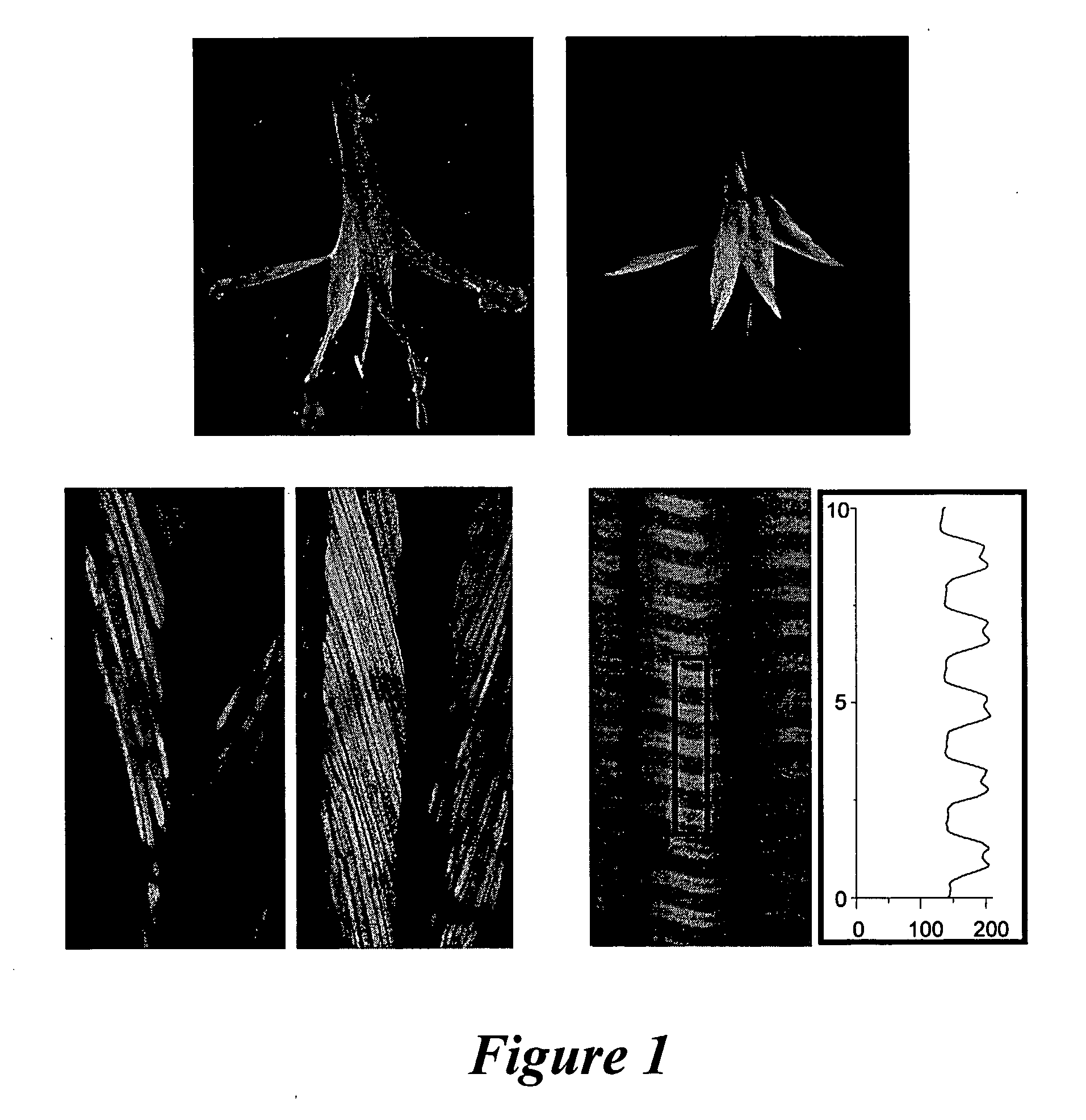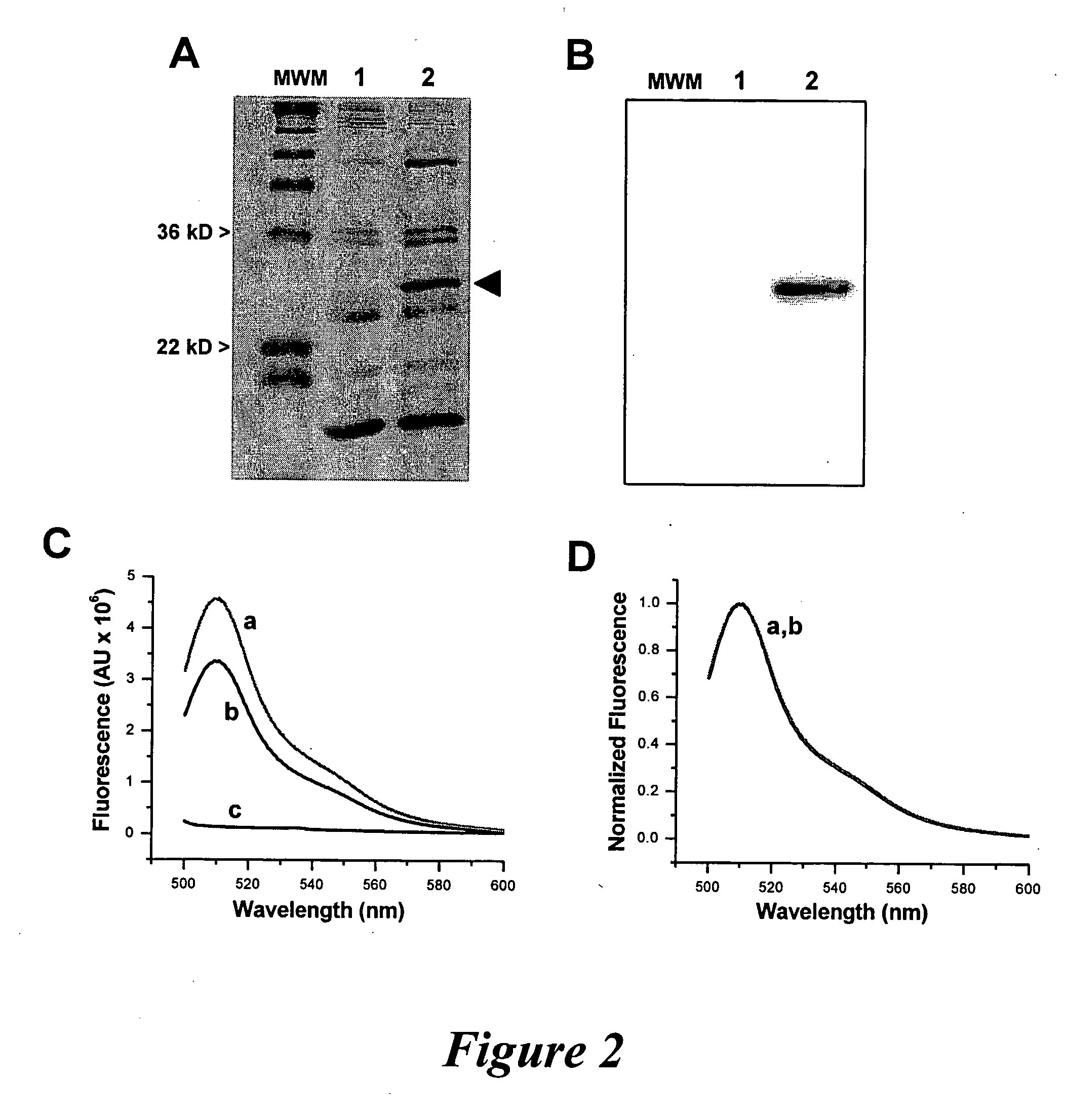Large-Scale Production of Recombinant Transmembrane and Cytosolic Proteins
a technology of cytosolic proteins and transmembrane, which is applied in the field of large-scale protein production, can solve the problems of severe limitations in the expression of fully-length replicas of a large number of eukaryotic proteins, prokaryotic expression systems, and sufficient quantity and quality of mammalian proteins for structural and functional studies
- Summary
- Abstract
- Description
- Claims
- Application Information
AI Technical Summary
Benefits of technology
Problems solved by technology
Method used
Image
Examples
example 1
In Vivo Expression of Green Fluorescent Protein in Skeletal Muscle
[0090]This example demonstrates the efficacy of the in vivo transfection of cytosolic proteins into skeletal muscle.
[0091]The muscles chosen for the physiological experiments were the flexor digitorum brevis (FDB) and the soleus, which are typical examples of fast and slow muscles, respectively. At least one advantage of these muscle groups is that plasmid (pDNA) solutions can be injected subcutaneously in the feet pads. Another advantage is that uniform electric fields between two parallel subcutaneous electrodes are attainable with this model.
[0092]To determine the efficacy of the in vivo transfection method described herein, plasmids (pEGFP-N2 and pECFP, Clontech) encoding enhanced green fluorescent protein (EGFP), or enhanced cyan fluorescent variant (ECFP) of the Aequorea victoria GFP were used to evaluate the EGFP / ECFP protein expression pattern in the muscle fibers using TPLSM. The efficiency of transfection is...
example 2
In Vivo Transfection of Proteins using Fluorescent Tags
[0109]This example demonstrated the use of fluorescent tags to gauge the level of efficiency of transfection of the proteins.
[0110]In order to investigate the pattern of the over-expression of other soluble proteins, adult mammalian skeletal muscle was transfected with DNA plasmids encoding for CFP-tagged (experiment), T7-tagged (control) recombinants of the muscle-specific soluble protein, β1a-subunit of the dihydropyridine receptor (β1a-DHPR), along side as GFP (control) alone. All plasmids were delivered by in vivo electroporation substantially as described above (e.g. delivering plasmid DNA in less than about 20 μg in mice to greater than about 150 μg in rats or larger animals; and from about 90V in mice to greater than about 200V in rats or larger animals).
[0111]Using TPLSM, the expression and localization of fluorescently tagged CFP-β1a-DHPR was determined. About 12 hours post transfection, expression of recombinant CFP-β1...
example 3
In Vivo Transfection and Production of Large Quantities of Transmembrane and Cytosolic Proteins
[0116]This example demonstrated the in vivo transfection and production of transmembrane and cytosolic (soluble) proteins.
[0117]In vivo electroporation of compositions consisting of various DNA (or cDNA) plasmids encoding for α1S-DHPR, RyR1, and Shaker channel transmembrane proteins was performed substantially similar to that described above, using fast and slow twitch muscle fibers from young anesthetized mice (e.g. extensor digitorum longus (EDL), soleus, tibialis anterior (SA), and flexor digitorum longus (FDB) and flexor digitorum quinti (FDQ)). Two (2) types of solutions were injected subcutaneously into the legs or footpads of the animals: A solution of 2 mg / ml hyaluronidase dissolved in pharmaceutical grade sterile saline filtered (after mixing) with 0.2 μm pore sterile filters; and an experimental solution containing 2-5 μg / μl of cDNA plasmids (e.g., α1S-DHPR) encoding soluble or t...
PUM
| Property | Measurement | Unit |
|---|---|---|
| Mass | aaaaa | aaaaa |
| Dimensionless property | aaaaa | aaaaa |
| Time | aaaaa | aaaaa |
Abstract
Description
Claims
Application Information
 Login to View More
Login to View More - R&D
- Intellectual Property
- Life Sciences
- Materials
- Tech Scout
- Unparalleled Data Quality
- Higher Quality Content
- 60% Fewer Hallucinations
Browse by: Latest US Patents, China's latest patents, Technical Efficacy Thesaurus, Application Domain, Technology Topic, Popular Technical Reports.
© 2025 PatSnap. All rights reserved.Legal|Privacy policy|Modern Slavery Act Transparency Statement|Sitemap|About US| Contact US: help@patsnap.com



